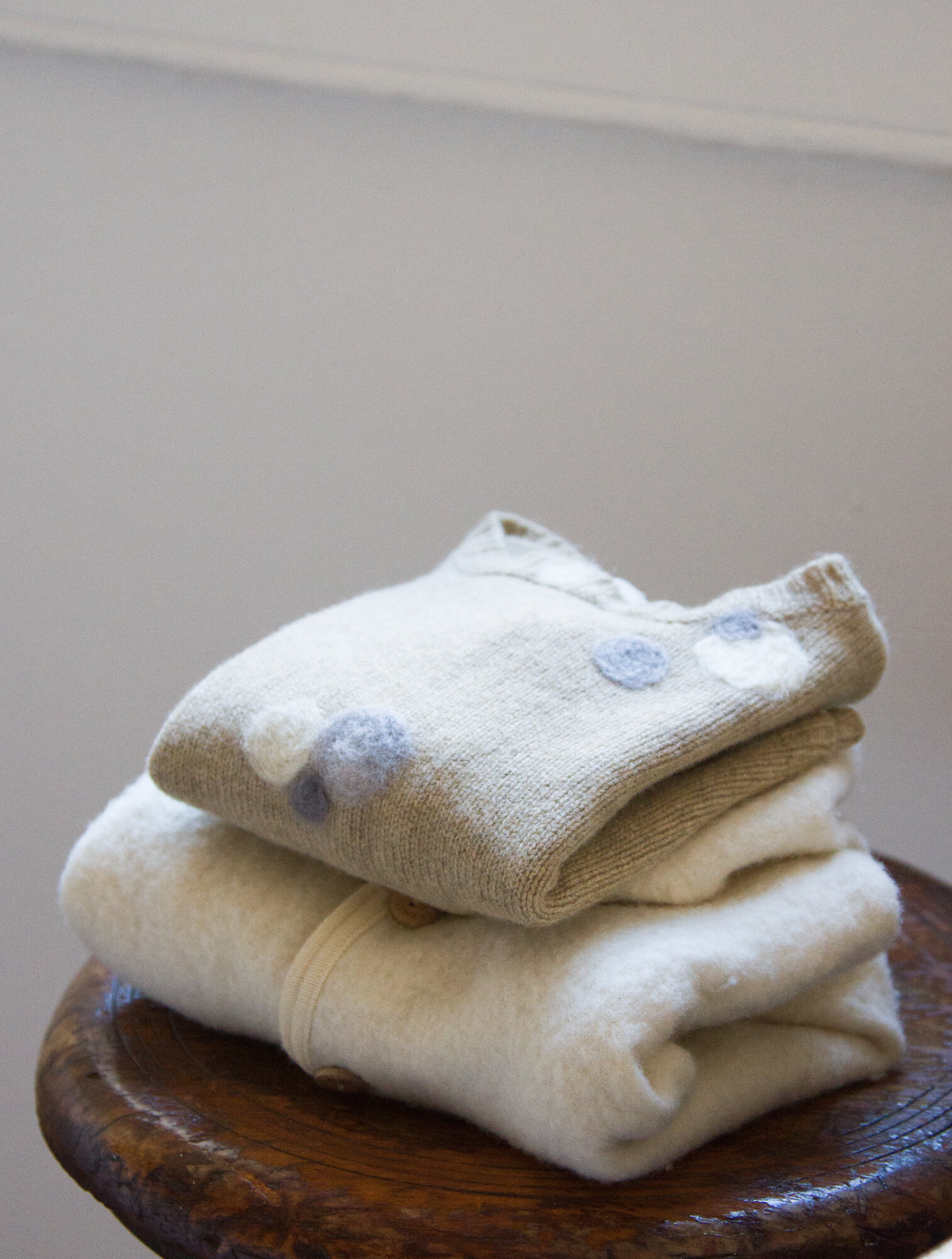
A few weeks ago I pulled out the storage bag where I keep the small amount of kids’ clothes that I’ve deemed special enough to keep for nostalgia sake, or that are otherwise waiting for the right-sized kid to fit into them. I wanted to see what few baby things I’d saved and to get a sense of what we might need with another little one on the way. To my delight I found a woolly fleece suit of Silas’s that I’d lent to my sister (and that we’d both forgotten she’d already returned to me), and a favorite wool sweater I’d received when Faye was a baby, that had since also been loved by Silas. Unfortunately, both beloved woolens had suffered a bit from time and our affection: I found a tear along a seam of the woolly suit and evidence that the sweater had been snacked on by unbeknownst-to-us resident bugs.
Felting to the rescue. In my thirty-five years I’d never embarked on a full felting repair of my own, but when over coffee with Rose, I bemoaned the fate of my favorite woolens, she assured me that I was up to the task. In typical Rose style, when she saw me next, she arrived with a pouch of materials I could borrow to make the fix.
The process was so easy and so satisfying. Not to mention, stress-relieving. It’s been such a great week for repeatedly stabbing an inanimate object with a sharp needle. Just one warning: Once you start, you’re not going to want to stop.
Materials needed and instructions below, plus a few woolly resources.
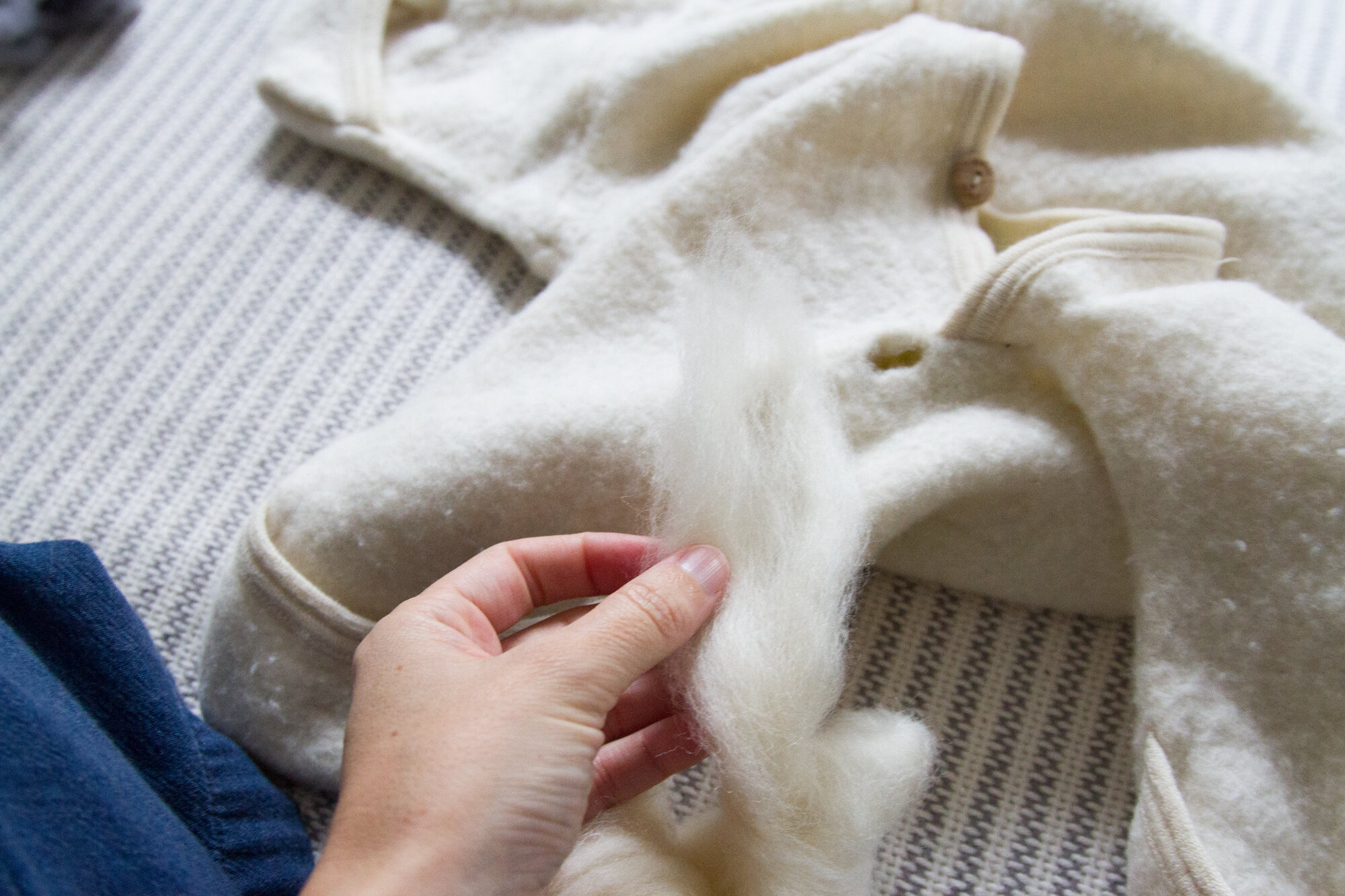
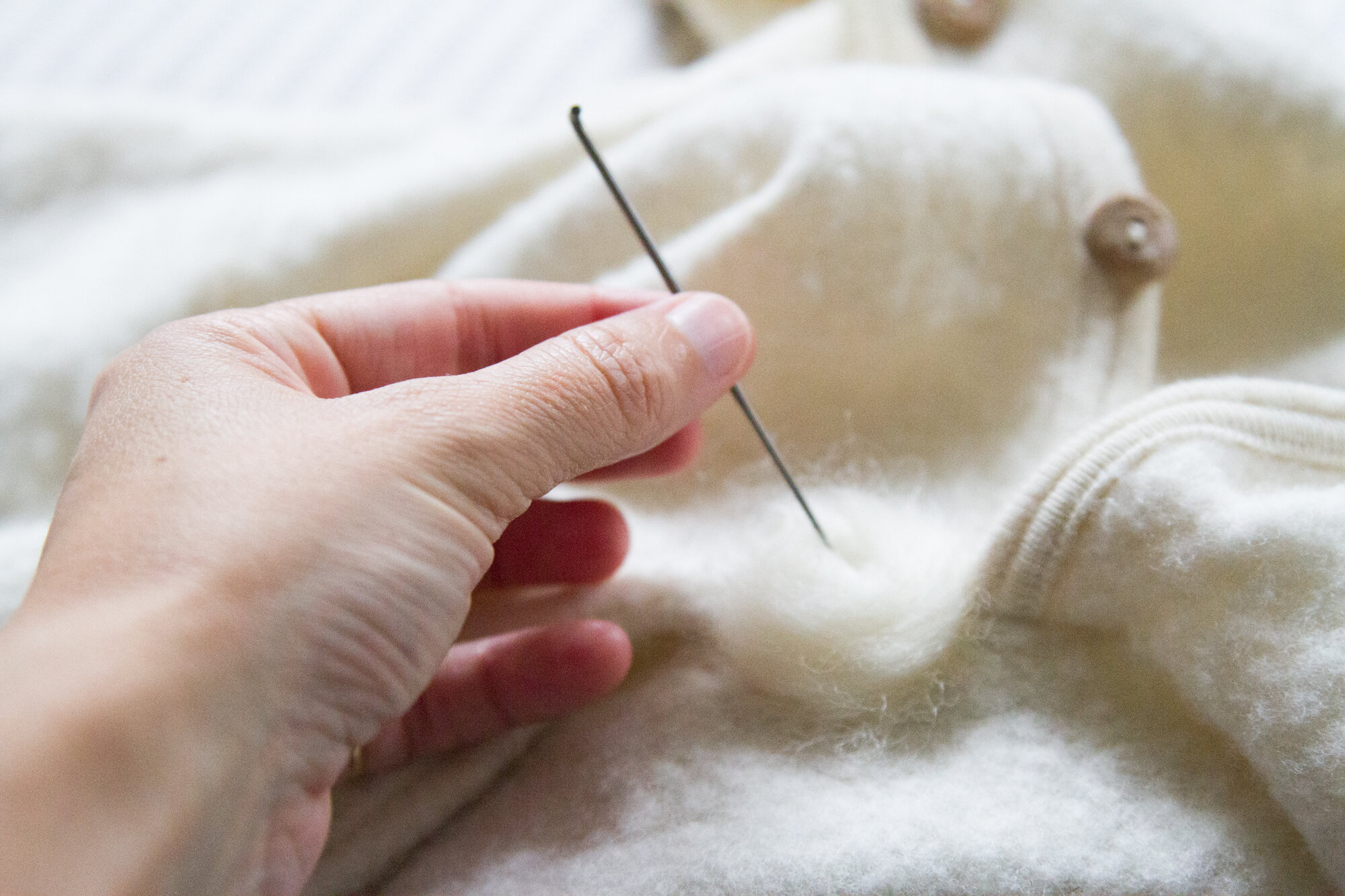
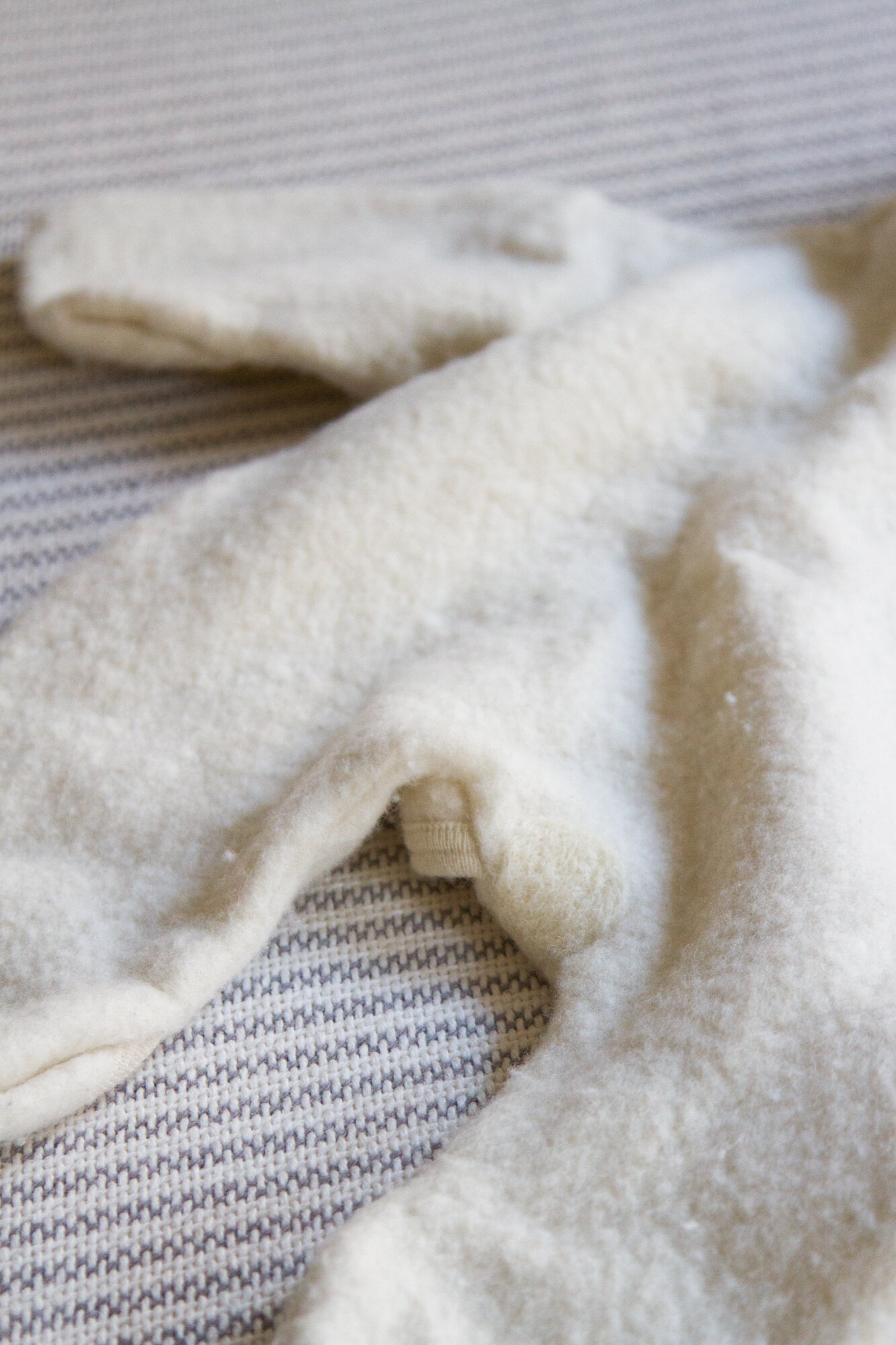
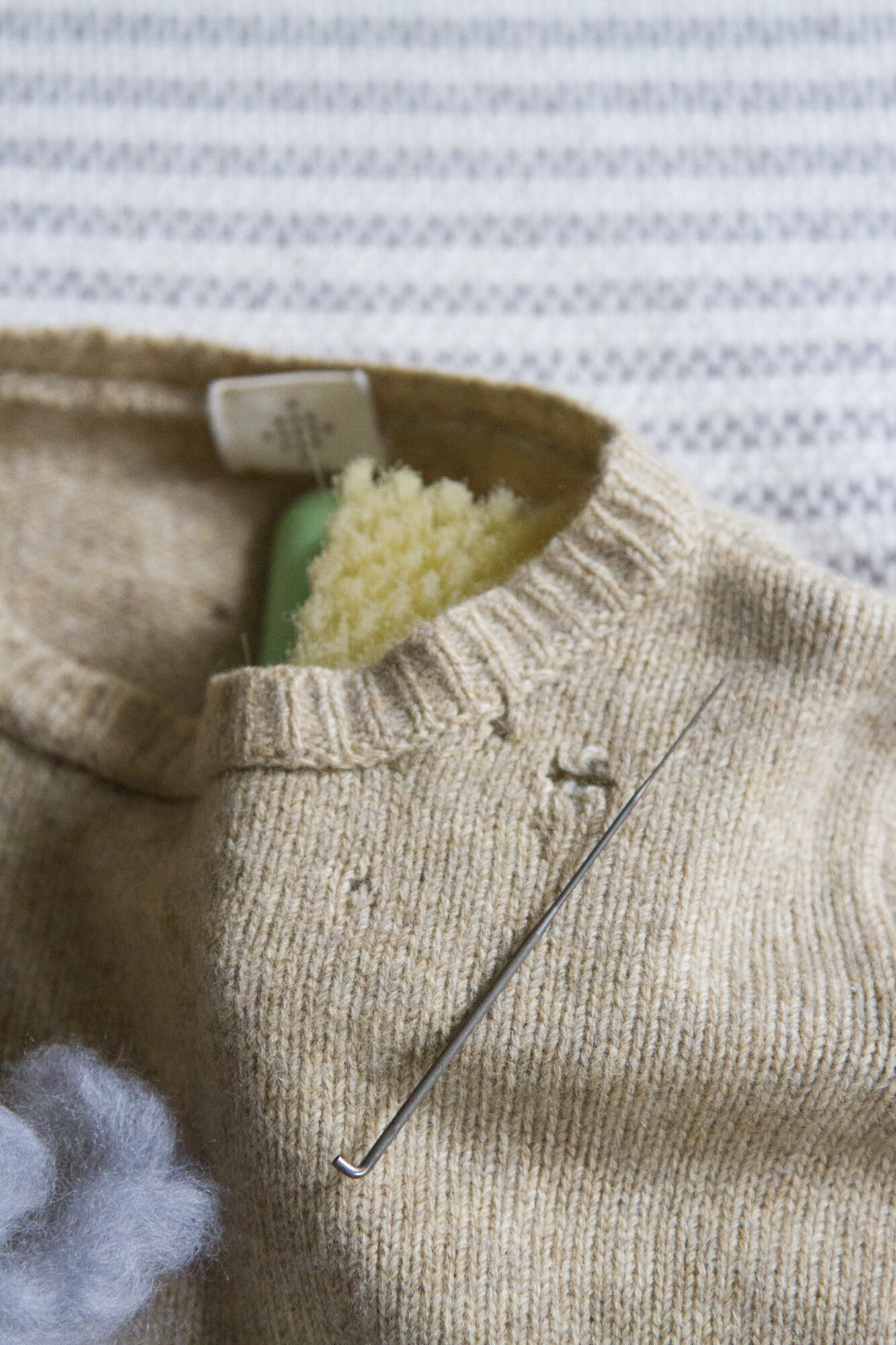
Materials
+ Wool item to be repaired (As a general rule, felting works best when working with 100-percent wool, though for smaller projects especially, don’t shy away from blends if that’s what you have. In my felting fervor, I had lots of luck felting over some goody bag masks that my kids were given, and they were decidedly not one-hundred percent wool.)
+ 100-percent wool roving
+ Felting needle (I borrowed a single needle from Rose to make these repairs and it was perfect. If you’re tackling a larger project or planning to felt a bunch, you might opt for a wooden needle felting tool that comes with a range of needles and the option to use multiple needles at the same time.)
+ Felting mat (I borrowed a felting mat similar to this bristle-style felting mat. You can also use a firm woolen mat as your felting surface (or, if you have one already destined for the landfill, a piece of dense styrofoam).
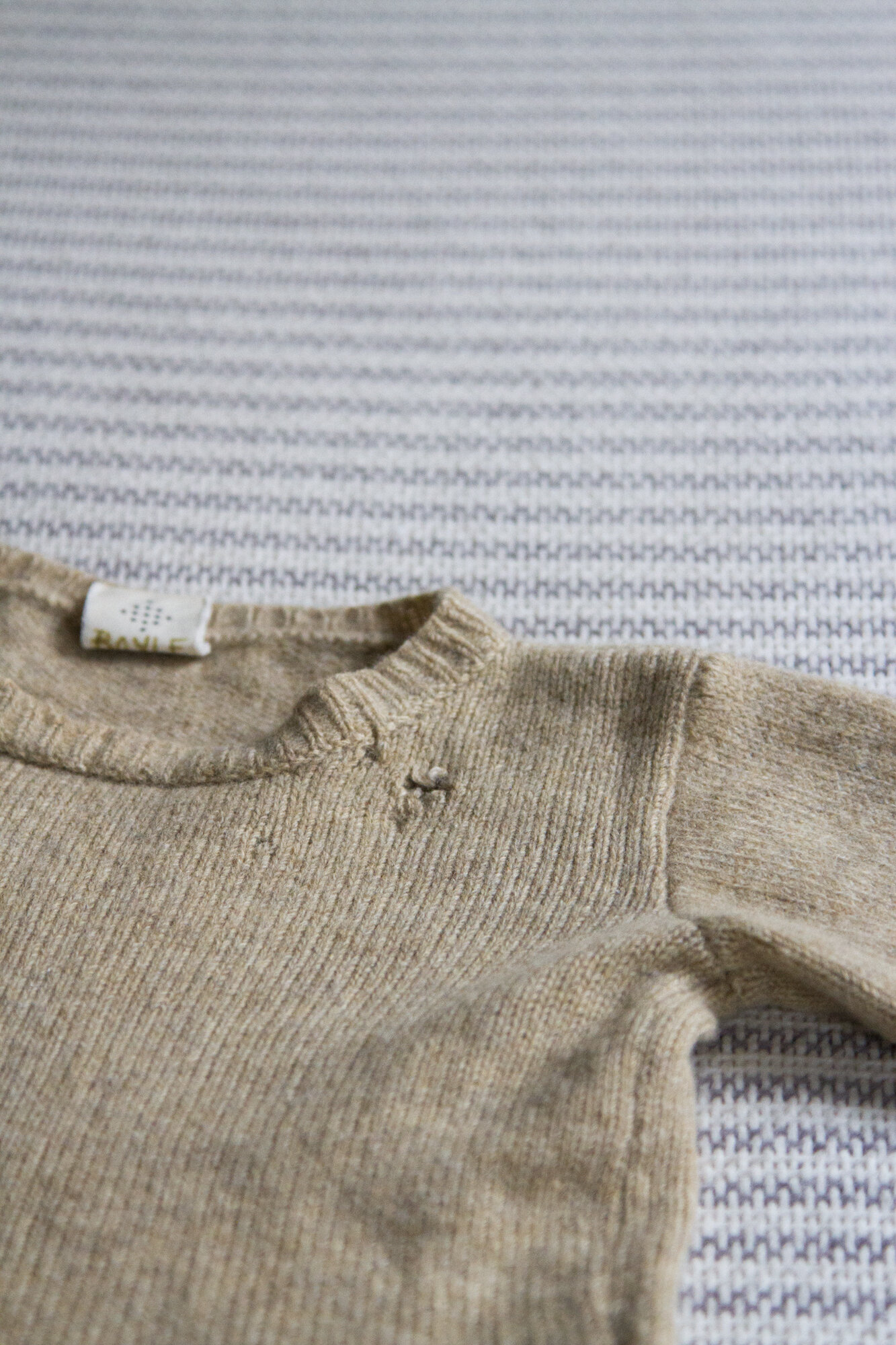
Instructions
+ If your sweater is damaged due to moths or other pests (like this one), make sure you’re starting with a clean sweater to ensure there are no larvae present.
+ Place your felting mat underneath the small hole or area in need of repair.
+ Tear (don’t cut) a piece of wool roving in the color and size that you need and use your fingers to shape it into a puffy sphere. Place the roving on top of the hole and use your needle to puncture the roving into the wool you’re seeking to mend.
+ With every pierce of the needle, the roving will adhere itself to the wool sweater. Continue piercing the roving until it is well adhered and flat against the surface of the sweater.
+ Note: I used circles here in contrasting shades because I was repairing a baby sweater. If circles aren’t your style, feel free to choose matching roving or to work your roving into a different shape for more subtle (or creative!) repairs.
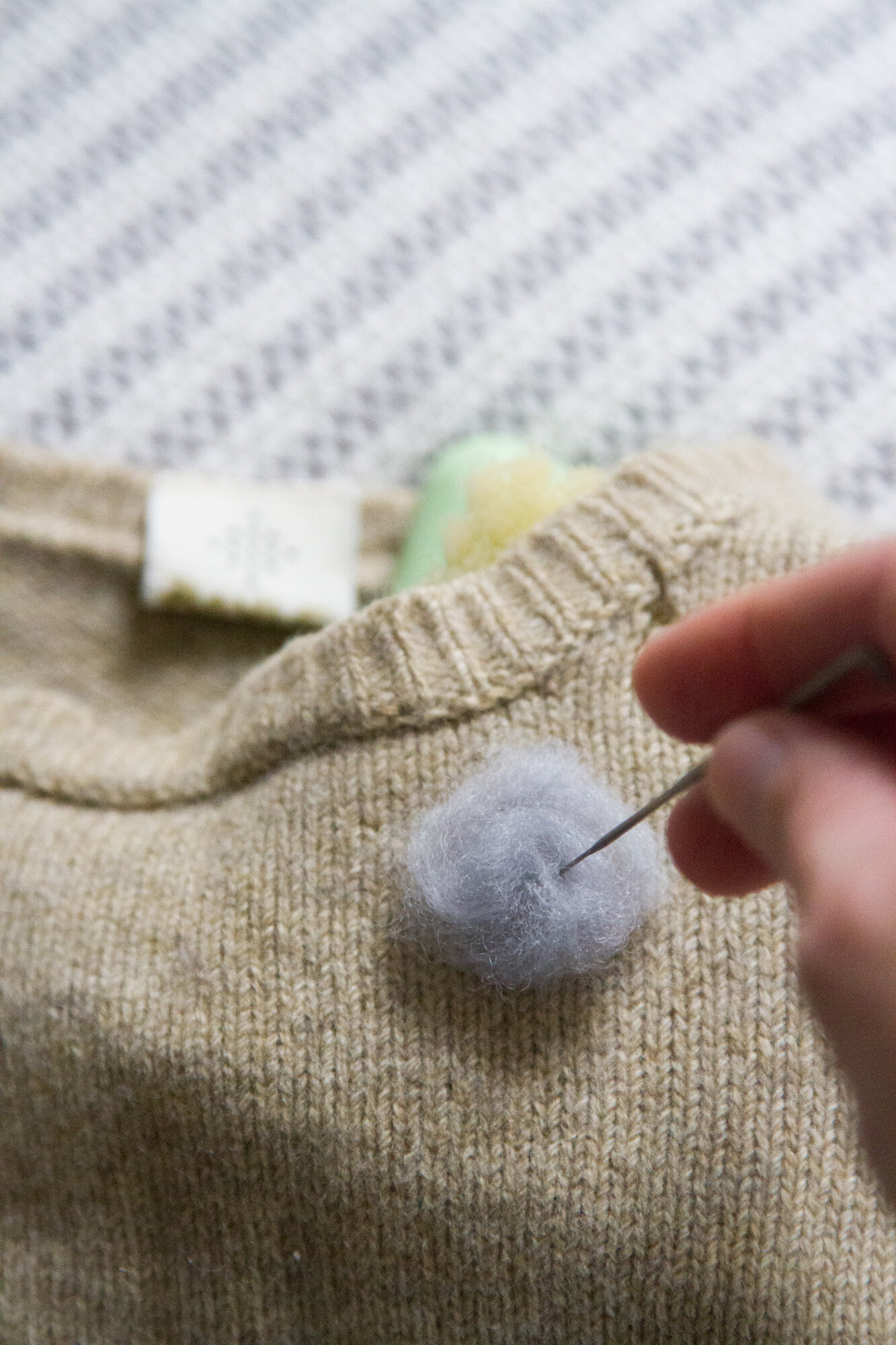
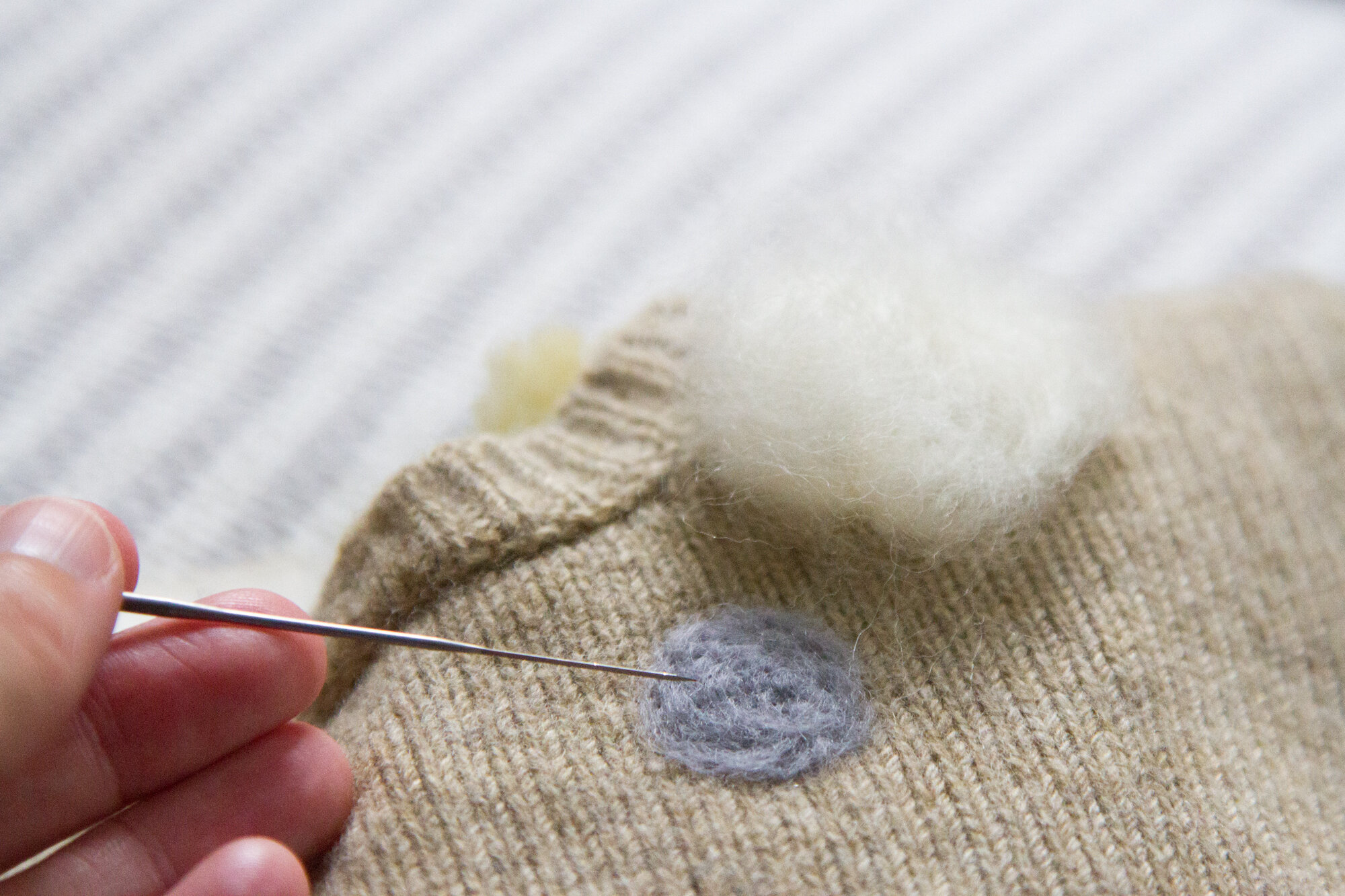
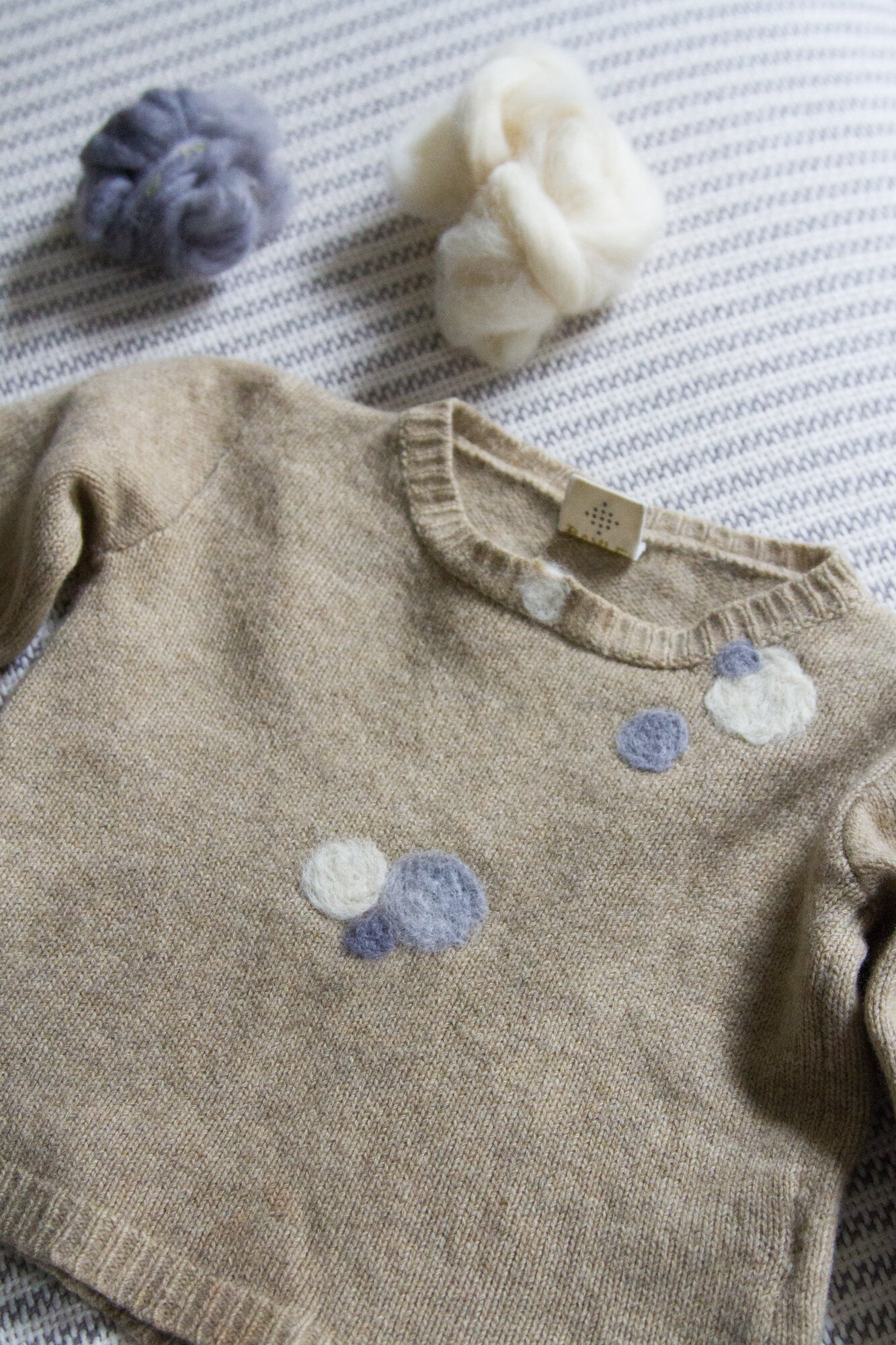
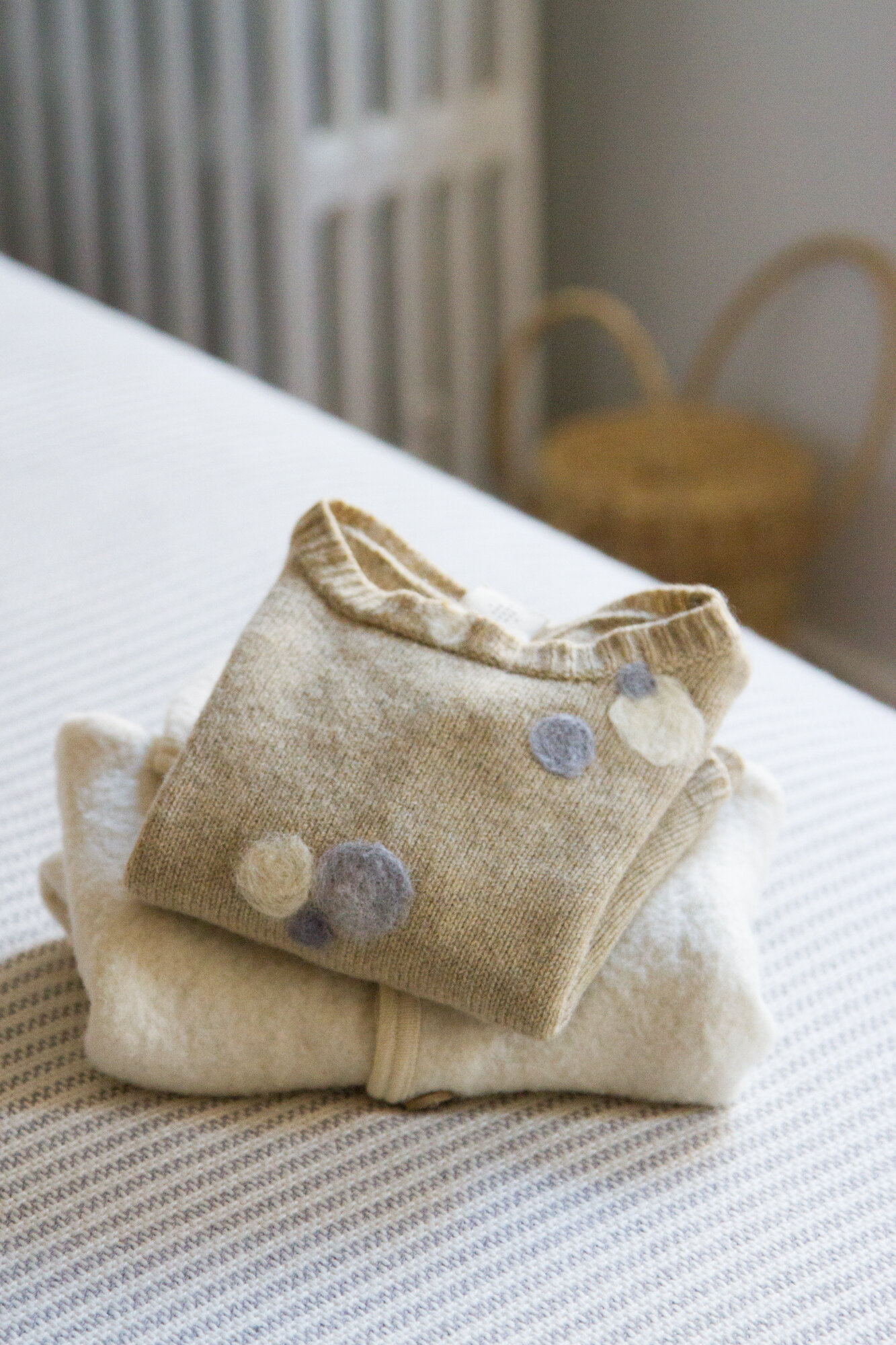
Other woolly things:
+ Fibershed is an inspiring nonprofit organization committed to developing regional and regenerative fiber systems on behalf of independent working producers. They do this work by “expanding opportunities to implement carbon farming, forming catalytic foundations to rebuild regional manufacturing, and through connecting end-users to farms and ranches through public education.” Head to their site to learn more about their Climate Beneficial Wool Certification and the soil-to-soil lifecycle. The Fibershed Marketplace is also a great place to search for wool products you can buy: Climate Beneficial Wool Roving among them!
+ Elizabeth Suzann, maker of my favorite wool cocoon, is launching Cold Weather Collection 2.0 next week, on October 28. With the collection comes the return of wool to the company’s product line. All of the wool in their new collection is traceable, domestic, and Climate Beneficial.
+ For kids, Chasing Windmills is a favorite shop for making cozy, wearable merino long johns. Misha & Puff is another favorite shop of ours for hand knit hats, scarves, and sweaters (you can even knit your own!). Their latest women’s collection launches October 29. (Just please stop asking me if I’m selling either of my sweaters. I love you, but no.)
+ My dear friend, collaborator, and lender of the felting supplies used above, Rose Pearlman, has a whole book of woolly projects coming out just in time for the holidays. Modern Rug Hooking, is available now for preorder and will be released on December 2.

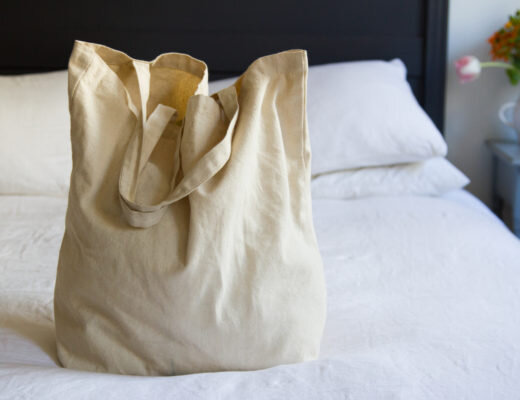
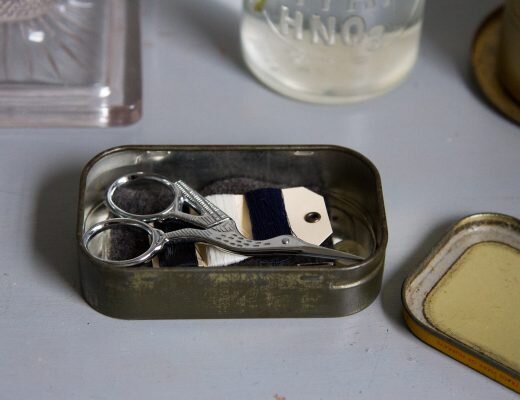

64 Comments
Moths aren’t the only insects that eat wool! Centipedes, cockroaches, silverfish, and house crickets often munch on wool clothing while looking for food residue – given that these items were used for young kids (who are not the neatest of eaters as a group) I would guess those other bugs are the culprit here.
ah, good thinking!
Carpet beetles were the wool munchers in our house. Lots of critters love wool it seems!
UGHHH we have those darn beetles!
This is going to change my life forever! Seriously I didn’t know you could repair wool this way! And super cute results.
Your previous post made me really sad, all my love from London! ❤️
Bay leaves keep moths away, that’s what they put in between the wool rugs in Morocco!
Oh – what a good idea. I recently got a thread up sweater that had a hole in it (they credited me the cost before I even received it)…this could be the perfect place to try it out.
wow this is so cool! when you pierce the roving do you also pull the needle through the cloth and out the other end like a needle and thread or you pull it out the same way it enters the cloth?
Good question: you pierce and pull right back out, just kind of stabbing the same area over and over.
gotcha! i wrote this then saw your IG story on the process. very cool, erin!
Hi just wondered once the dry felting is done what happens to the added wool when the garments are hand/machine washed as usual? Does it pucker or loose shape?
We’ve only hand-washed and haven’t noticed any puckering!
What a brillant idea! I gonna try because like jeans, a old sweater is one of the best item in a minimalist wardrobe. Have a lovely day!
This is so helpful. Thank you! As a knitter, this was new to me. I wonder if I leftover yard could be used in a similar way to the wool roving if it were frayed. If so, I’d have plenty of material for matching patches.
I’m so glad you posted about this! I have two sweaters that need elbow patches. I have wanted to try Erica’s DIY method she wrote about on Honestly WTF, but for two years I have stalled out buying the supplies. (Too many different websites, not knowing how much roving to purchase, etc.) Thanks to you, I actually ordered the supplies today! Thank you so much.
Hi Judith! I actually used a bit of frayed yarn to make some of the detail work on the felt masks I “improved” for the kids! The yarn I used was quite bulky and similar to roving in that it could be pulled apart, so I think that’s why I had success!
Wait.. people are randomly asking you to sell them your sweaters? lol. I have Misha & Puff’s launch date already on my calendar!
all. the. time.
lol too, I clearly underestimate your inbox(es). Bonne continuation, Erin!
This happens to me too! Unprompted. Unsolicited. And the answer is always no. [shakes head]
This is just delightful! I love the polka dots you ended up with on that sweater. In my own quest to be a better steward of my clothing, I learned how to knit over a hole in a sweater I’d over-eagerly de-fuzzed. I had to watch a YouTube video about a thousand times to comprehend the steps, but I managed to mend that hole. I was pretty proud! You or other readers might also be interested in Reunion Yarn Company (reunionyarn.com), which offers workshops in sweater-unraveling so you can reuse yarn. And the last thing that comes to mind is the infinite variety of projects that can come out of felting wool sweaters by deliberately shrinking them: My mom made merino wool pants and sweaters from old adult sweaters for my two little ones, as well as a pair of running tights for me. Like you said, once you get on a roll, it’s hard to stop. Repurpose allll the wool!
That’s so cool! Thanks for sharing!
Genius idea! Wish I’d known about this technique years ago! Thanks, Erin.
Ugh-moths! We have a family of them that have been eating our rugs. We’ve not had any luck getting rid of them with non toxic solutions- they’re so frustrating! I’ll be curious to hear what you do.
You can get morh traps from places like tractor supply. The triangle tent has a sticky substance that attracts the moths. Stick bay leaves under rugs and on pantry shelves.
Too cute!!
This is so clever! I haven’t thought one could use needlefelting for repairs, but now I got to try this 😀
Lovely, lovely. Both the sentiment and the workmanship.
Whoa! I’m not sure why I’ve never thought of mending holes with felting. Brilliant. We have a small felting kit my kids have used and they love stabbing that needle into the roving – very therapeutic!
When I first discovered needle fleeting, as a teenager, I covered over the spots where I had lovingly worn the fur off my favorite stuffed bear!
So sweet!
Aw so much love, hope and dreams go into the ritual of washing, mending and carefully folding baby clothes
You are an amazing mama of 3 beautiful caring little people, what could be better than that xxx
Stella Neptune makes fabulous upcycled cashmere iron on patches. Same idea, a bit of a more formal look.
Oh I remember seeing a tutorial to felt heart shaped elbow patches onto a sweater – it was so cute! I love the ‘bubbles’ you have made for this little sweater as well. Precious! I think it is so special and fun to see pictures of siblings (and cousins!) in the same article of clothing – I was so lucky that my mother had saved quite a bit of our baby clothing and my daughter got to wear outfits that my sister and I had worn – and even a few things of my brothers!
Wondering how you recommend washing the wool to be sure the larvae are all gone. Does the water need to be hot hot hot? Will hot water cause further damage? Thank you for this; I’ve pulled a sweater out that was munched 🙁 Grateful to have a fix now!
We hand washed in cool water with soap just as always.
Freezing wool items for several days is supposed to kill moth larvae, so when I’m concerned about a sweater or other woolen item, I usually stash it in my freezer (in a sealed bag or container) for a week or so in addition to washing. I wouldn’t increase the washing temperature since the heat might shrink the fibers. I don’t know how many sweaters or scarves have taken a turn in my freezer over the years, sometimes just a precautionary measure because I really love them. 🙂
Also: DRY CLEANING. We had a moth infestation 2 years ago and did combination freezer and dry cleaning depending on the quality and material of the item.
Brilliant. Weirdly, I have some roving lying around from my former life as a historical interpreter (spinning wool, amongst other activities), and never knew what to do with it. Now I’m going to hunt through my sweaters to see if any of them need mending!
Fantastic timing. I was just about to take my damaged sweaters to the salvation army. Do you think this same method would work for socks? I hate getting rid of my lovely wool socks when the heels are worn.
I’m planning to do a few of mine! Will try to report back!
Please do!
Oh my, I have just fallen down a rabbit hole. Loving this too much!
Genius!
Not only mended, but updated! How cute and clever ♥︎
Since I couldn’t comment on the previous post I just wanted to say congratulations to you and your family on your pregnancy. Best wishes for a healthy child who will grow up to join us as a happy and productive citizen.
thanks so much.
This boggles my mind. I need to try it. I think I’d add some embroidery over and around for fun but I do love the dot effect
If anyone is interested in specific shapes ( I can do a heart, but that’s about it!),try using a cookie cutter as a template…the small “ canapé” cutters are perfect to use as a guide. Set them down , stuff in the roving, poke, and viola! You’ve got the perfect shape!! I’m going to Japan in a few weeks and plan on hitting one of the stores that have, literally, thousands of small “cookie” cutters they use for their veggies and such for the kiddos lunch boxes. A great thing to keep a lookout in yard/estate sales….
A friend & I have been haunting thrifts for merino & cashmere (esp. in menswear – larger!), felting them & upcycling: mittens, hoods-to-button-into-jean-jackets, bicycle seat covers, berets, newsboy hats – so fun!
and Erin, I thought you might enjoy this. https://www.cbc.ca/news/canada/edmonton/cree-singing-protege-1.5336414
Greta Thunberg was here in Edmonton last week, speaking at a rally on the steps of our Legislature. this wonderful clip is of a boy, singing & drumming w/ his grandmother, telling us to get up and dance. who knows what our children will offer the world?
Help,
I have successfully needle felted wool from the local sheep farmers to a cotton sweater, onto felt gloves and a leather cap. Now, why???? Does it not work on my daughters cashmere jacket??? Soooo frustrating!
Please help
Do you think this is possible on the fingertips of gloves? I came back to this post to gather supplies for my favorite gloves, but then realized I can’t really access the inside of the hole area.. 🙁
I think there are lots of possibilities here! I’d try stuffing an alternative brush or pad into the finger of the glove! Certainly a small “finger” of dense foam would work well and would be easiest, but if you don’t want to use foam, I can imagine a small cleaning brush or something similar working! Depending on the size, I’m not convinced that a toothbrush might not be perfect! Basically you want something in there so that you don’t end up felting the two sides of the finger together. It should be supple enough that your felting needle won’t bend when it hits it, but not so soft that you end up felting the stuffing! Good luck! I’m sure you’ll find a workaround!
Hi! This looks adorable! Can you use wool to felt a hole in a cashmere sweater? I have a cashmere sweater for my three month old that I’d like to mend 🙂
I think so!
what does the mend look like on the back side or what should be done to make the mend acceptable on the back side?
looks fairly similar on the reverse but slightly more subtle! you can also felt from the reverse side for the exact same look!
Hi Erin, how does this mending method hold up? Have you needed to add some wool to the original hole? I have seen so many different approaches to mending knits, but still love the look of this the most. Thanks for sharing!
It’s great! Calder went to daycare wearing it today!
Nice. btw great to hear the words daycare and today in the same sentence. Have a great day, Erin!
SO. GREAT.
Hey there – Can you felt on cashmere? … or do you have suggestions for repairs? x
Yes! (I think so!)
This finally gave me to confidence to fix my daughters favorite thrifted wool sweater that I’ve been to scared to try despite her frequent requests 😉 Just ordered the supplies! Thank you for the confidence boost!
Comments are moderated.